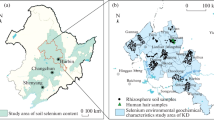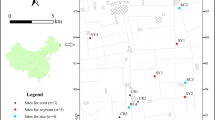Abstract
Within the range of 0.01 km mini-landscape in Yutangba, Enshi, Hubei Province, the content of Se in corn is very high. The average Se contents in root, stem, leaf and seed of corn were estimated to be 4.36±3. 27mg/kg, 3.08±2.24 mg/kg, 9.74±7.62mg/kg, and 8.07±5.02mg/kg, respectively. The research results show that there is a significantly positive correlation between corn selenium and soil selenium, and thus according to the distribution of Se in corn, three subregions can be divided in Yutangba. The content of selenium in corn is controlled by that of soil. A little variation in selenium content in soil will lead to a considerable corresponding variation in corn. So it is deduced that the organs that contain relatively high Se in plants may be used as a sensitive selenium indicator of Se levels in the environment.
Similar content being viewed by others
References
Arvy, M. P., 1992, Some aspects of selenium relationships in soils and plants: Commun. Soil Sci. Plant Anal., v. 23, n. 13-14, p. 1397–1407.
Bisbjerg, B. and G. Gissel-Nielsen, 1969, The uptake of applied selenium by agriculture plants: I. The influence of soil type and plant species: Plant and Soil, v. 31, n. 2, p. 287–299.
Jiang Zigang and Gu Xuemei, 1986, Data statistics and quality guarantee in analysis and measurement: Shanghai, East China University of Chemical Engineering Publishing House, p. 216–219 (in Chinese).
Johnsson Lars, 1991, Selenium uptake by plants as a function of soil type, organic matter content and pH: Plant and Soil, v. 133, p. 57–64.
Mao Dajun, Zheng Baoshan, and Su Hongcan, 1997, Medical and geographical features of selenium poisoning in Yutangba: Bulletin of Endemic Diseases, v. 12, n. 2, p. 59–259 (in Chinese).
Peng An, Wang Zijian, P. D. Whanger, G.F. Combs, J.Y. Yeh et al., 1995, Environmental biology, and inorganic chemistry of selenium: Beijing, China Environmental Science Press, p. 1–40 (in Chinese).
Sharmasarkar Shankar and F. Vance Geoge, 1995, Characterization and correlation of soil and plant selenium in some range and coal mine environments of Wyoming: Commun. Soil Sci. Plant Anal., v. 26, n. 15–16, p. 2577–2591.
Severson, R.C., J.R. Fisher, E. Scott, and L.P. Gough, 1991, The Proceedings of the 1990 Billings land reclamation symposium on selenium in arid and semiarid environments, Western United States: U. S. Geological Survey Circular 1064, p. 55–64, 83–105.
Tan Jianan (compiled), 1989, Environmental selenium and health: Beijing, People’s Hygiene Publishing House, p. 1–5, 229–224 (in Chinese).
Tan Jianan and Huang Yijian, 1991, Selenium in geo-ecosystem and its relations to endemic diseases in China: Water, Air and Soil Pollution, v. 57–58, p. 59–68.
Yang Guangqi, Wang Shuzheng, Zhu Ruihua, Sun Shuzhuang, Li Shengsi et al., 1981, Investigation on loss of hair and nail disease of unknown etiology—endemic selenosis: Acta Acad. Med. Sci., v. 3 (suppl.), n. 2, p. 1–6 (in Chinese).
Zhao Chengyi, Ren Jinghua, and Xue Chengze, 1993, Selenium in soil in the Se-rich area of Zhiyang: Journal of Soil, v. 30, n. 3, p. 253–259 (in Chinese with English abstract).
Zheng Baoshan, Hong Yetang, Zhao Wei, Zhou Huaiyang, Xia Weiping, Su Hongcan, Mao Dajun, Yan Liangrong, and I. Thornton., 1992, Se-rich carbonaceous silicalite in western Hubei and its relation with endemic selenium poisoning: Science Bulletin of China, v. 37, n. 11, p. 1027–1029.
Zheng Baoshan, Yan Liangrong, Ma Dajun, Su Hongcan, Zhou Huaiyang, Xia Weiping, Hong Yetang, Zhao Wei, Cheng Fu, Zhu Xiaoqing, and I. Thornton, 1993, Selenium resources in western Hubei and their developing strategy: Journal of Natural Resources, v. 8, n. 3, p. 204–212 (in Chinese with English abstract).
Zhu Jianming, Zheng Baoshan, Wang Zhongliang, Zhu Guangwei, Su Hongcan, and Mao Dajun, 1998, The distribution of Se in soil in the Yutangba high-Se mini-landscape environment and its affecting factors: Environmental Science, v. 19, n. 6, p. 33–36 (in Chinese with English abstract).
Author information
Authors and Affiliations
Additional information
This research project was financially supported jointly by the National Natural Science Foundation of China (Grant No. 49373186) and the National Outstanding Young Scientists Foundation of China (Grant No. 49625304).
Rights and permissions
About this article
Cite this article
Zhu, J., Zheng, B., Wang, Z. et al. Distribution of selenium in corn and its relationship with soil selenium in Yutangba mini-landscape. Chin. J. of Geochem. 19, 161–166 (2000). https://doi.org/10.1007/BF03166872
Issue Date:
DOI: https://doi.org/10.1007/BF03166872




